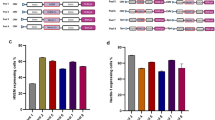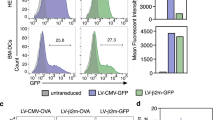Abstract
Lentiviral vector (LV)-mediated gene therapy bears an intrinsic risk of insertional mutagenesis following integration into the host genome. Nonintegrative LVs may offer an alternative avenue at least in nondividing cells where episomal viral DNA persists stably. Owing to their central role in immune system functions, differentiated dendritic cells (DCs) offer an interesting cell target for these vectors. We have previously described that the transduction of DCs with wild-type HIV-1-derived vectors can be considerably improved by providing DCs with noninfectious virion-like particles (VLPs) carrying Vpx (Vpx-VLPs), a nonstructural protein coded by members of the SIVSM/HIV-2 lineage that removes a specific restriction to lentiviral infection in these cells. Here, we describe that the transduction efficiency of DCs with nonintegrative HIV-1 vectors can also be improved via Vpx-VLPs that promote the accumulation of complete and episomal viral DNA. In this setting, Vpx increases both the number of transduced cells and the levels of transgene expression. Thus, these results describe a simple procedure by which transduction of differentiated DCs can be achieved at low viral inputs with safer LVs to improve both the number of transduced cells and the levels of transgene expression.
This is a preview of subscription content, access via your institution
Access options
Subscribe to this journal
Receive 12 print issues and online access
$259.00 per year
only $21.58 per issue
Buy this article
- Purchase on Springer Link
- Instant access to full article PDF
Prices may be subject to local taxes which are calculated during checkout



Similar content being viewed by others
References
Hacein-Bey-Abina S, Von Kalle C, Schmidt M, McCormack MP, Wulffraat N, Leboulch P et al. LMO2-associated clonal T cell proliferation in two patients after gene therapy for SCID-X1. Science 2003; 302: 415–419.
Bushman FD . Integration site selection by lentiviruses: biology and possible control. Curr Top Microbiol Immunol 2002; 261: 165–177.
Yanez-Munoz RJ, Balaggan K, MacNeil A, Howe SJ, Schmidt M, Smith AJ et al. Effective gene therapy with nonintegrating lentiviral vectors. Nat Med 2006; 12: 348–353.
Saenz DT, Loewen N, Peretz M, Whitwam T, Barraza R, Howell KG et al. Unintegrated lentivirus DNA persistence and accessibility to expression in nondividing cells: analysis with class I integrase mutants. J Virol 2004; 78: 2906–2920.
Philippe S, Sarkis C, Barkats M, Mammeri H, Ladroue C, Petit C et al. Lentiviral vectors with a defective integrase allow efficient and sustained transgene expression in vitro and in vivo. Proc Natl Acad Sci USA 2006; 103: 17684–17689.
Nightingale SJ, Hollis RP, Pepper KA, Petersen D, Yu XJ, Yang C et al. Transient gene expression by nonintegrating lentiviral vectors. Mol Ther 2006; 13: 1121–1132.
Loewen N, Leske DA, Chen Y, Teo WL, Saenz DT, Peretz M et al. Comparison of wild-type and class I integrase mutant-FIV vectors in retina demonstrates sustained expression of integrated transgenes in retinal pigment epithelium. J Gene Med 2003; 5: 1009–1017.
Fang JY, Mikovits JA, Bagni R, Petrow-Sadowski CL, Ruscetti FW . Infection of lymphoid cells by integration-defective human immunodeficiency virus type 1 increases de novo methylation. J Virol 2001; 75: 9753–9761.
Wu Y, Marsh JW . Selective transcription and modulation of resting T cell activity by preintegrated HIV DNA. Science 2001; 293: 1503–1506.
Banchereau J, Briere F, Caux C, Davoust J, Lebecque S, Liu YJ et al. Immunobiology of dendritic cells. Annu Rev Immunol 2000; 18: 767–811.
Gruber A, Kan-Mitchell J, Kuhen KL, Mukai T, Wong-Staal F . Dendritic cells transduced by multiply deleted HIV-1 vectors exhibit normal phenotypes and functions and elicit an HIV-specific cytotoxic T-lymphocyte response in vitro. Blood 2000; 96: 1327–1333.
Tan PH, Beutelspacher SC, Xue SA, Wang YH, Mitchell P, McAlister JC et al. Modulation of human dendritic-cell function following transduction with viral vectors: implications for gene therapy. Blood 2005; 105: 3824–3832.
Goujon C, Jarrosson-Wuilleme L, Bernaud J, Rigal D, Darlix JL, Cimarelli A . With a little help from a friend: increasing HIV transduction of monocyte-derived dendritic cells with virion-like particles of SIV(MAC). Gene Therapy 2006; 13: 991–994.
Goujon C, Riviere L, Jarrosson-Wuilleme L, Bernaud J, Rigal D, Darlix JL et al. SIVSM/HIV-2 Vpx proteins promote retroviral escape from a proteasome-dependent restriction pathway present in human dendritic cells. Retrovirology 2007; 4: 2.
Naldini L, Blomer U, Gallay P, Ory D, Mulligan R, Gage FH et al. In vivo gene delivery and stable transduction of nondividing cells by a lentiviral vector. Science 1996; 272: 263–267.
Mangeot PE, Negre D, Dubois B, Winter AJ, Leissner P, Mehtali M et al. Development of minimal lentivirus vectors derived from simian immunodeficiency virus (SIVmac251) and their use for gene transfer into human dendritic cells. J Virol 2000; 74: 8307–8315.
Goujon C, Jarrosson-Wuilleme L, Bernaud J, Rigal D, Darlix JL, Cimarelli A . Heterologous human immunodeficiency virus type 1 lentiviral vectors packaging a simian immunodeficiency virus-derived genome display a specific post-entry transduction defect in dendritic cells. J Virol 2003; 77: 9295–9304.
Lu R, Limon A, Devroe E, Silver PA, Cherepanov P, Engelman A . Class II integrase mutants with changes in putative nuclear localization signals are primarily blocked at a postnuclear entry step of human immunodeficiency virus type 1 replication. J Virol 2004; 78: 12735–12746.
Sharova N, Wu Y, Zhu X, Stranska R, Kaushik R, Sharkey M et al. Primate lentiviral Vpx commandeers DDB1 to counteract a macrophage restriction. PLoS Pathog 2008; 4: e1000057.
Srivastava S, Swanson SK, Manel N, Florens L, Washburn MP, Skowronski J . Lentiviral Vpx accessory factor targets VprBP/DCAF1 substrate adaptor for cullin 4 E3 ubiquitin ligase to enable macrophage infection. PLoS Pathog 2008; 4: e1000059.
Acknowledgements
We are indebted to Jeanine Bernaud and Dominique Rigal for help with blood sample collection. AC received support of Sidaction and the ANRS.
Author information
Authors and Affiliations
Corresponding author
Rights and permissions
About this article
Cite this article
Berger, G., Goujon, C., Darlix, JL. et al. SIVMAC Vpx improves the transduction of dendritic cells with nonintegrative HIV-1-derived vectors. Gene Ther 16, 159–163 (2009). https://doi.org/10.1038/gt.2008.128
Received:
Revised:
Accepted:
Published:
Issue Date:
DOI: https://doi.org/10.1038/gt.2008.128
Keywords
This article is cited by
-
A CRISPR screen for factors regulating SAMHD1 degradation identifies IFITMs as potent inhibitors of lentiviral particle delivery
Retrovirology (2018)
-
Vpx rescue of HIV-1 from the antiviral state in mature dendritic cells is independent of the intracellular deoxynucleotide concentration
Retrovirology (2014)
-
Design of a Novel Integration-deficient Lentivector Technology That Incorporates Genetic and Posttranslational Elements to Target Human Dendritic Cells
Molecular Therapy (2014)
-
Simian immunodeficiency virus-Vpx for improving integrase defective lentiviral vector-based vaccines
Retrovirology (2012)
-
SAMHD1 restricts HIV-1 infection in resting CD4+ T cells
Nature Medicine (2012)



